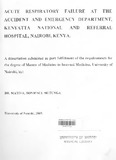| dc.contributor.author | Mativa, Boniface M | |
| dc.date.accessioned | 2013-05-24T07:17:27Z | |
| dc.date.available | 2013-05-24T07:17:27Z | |
| dc.date.issued | 2009 | |
| dc.identifier.citation | Master of Medicine in Internal Medicine, | en |
| dc.identifier.uri | http://erepository.uonbi.ac.ke:8080/xmlui/handle/11295/25151 | |
| dc.description.abstract | Background:
Acute respiratory failure (ARP) is a common presentation at the Accident and Emergency
(A&E) department. Delay or failure to identify ARP can result in significant morbidity and
mortality. Advances in assisted respiratory support and oxygen therapy for patients in ARF have
had a positive impact on overall prognosis. The burden of ARP at the Kenyatta National Hospital
(KNH) Accident and Emergency (A&E) department is unknown. Outcome in both short and
long-terms in and out of hospital is unknown, too.
Objective:
The main objective of this study was to determine the prevalence of acute respiratory failure,
identify the causes and document the outcome up to two weeks in hospital in patients presenting
with acute dyspnoea to the A&E department of KNH.
Methods:
In this prospective descriptive study, all patients aged 13years or more, presenting to the A&E
department, KNH with acute dyspnoea were screened for clinical as well as laboratory evidence
of ARF by pulse oximetry and baseline arterial blood gas analysis (ABG). A chest radiograph
was taken in all patients. Other tests were done as clinically indicated and all findings
documented. The primary clinical diagnosis associated with the ARF was determined and
documented. Patients were followed up by alternate day ABG till death/recovery or till the
fourteenth day of hospitalization, whichever came earlier. The outcome was documented.
Outcome Measures:
Outcome events were either full recovery from ARF, persisting respiratory failure (acute
evolving into chronic) or death. The time duration to each outcome was documented.
Results:
Thirteen thousand and three patients age 2: 13 years were seen at the Accident and Emergency
department during the study period. Two hundred and eighty six of them presented in acute
dyspnoea, and 83 were in ARF. The period prevalence of ARF was 0.6% (95% Cl, 0.47-0.73),
Xl
with 29.02% (95% Cl, 28.2-29.8) of all acutely dyspnoeic patients in ARF. Majority of patients
(65.1%) were male. M: F ~ 2: 1. Most patients were young, with peak age as 31-40 years of age.
Most patients presented with symptoms of S 2 days in duration, which was significantly
associated with an adverse outcome (OR 4.135, p-value 0.003). Acute trauma was the
commonest cause of ARF. Central causes of ARF were significantly associated with an adverse
outcome. 65.1% Of all patients in ARF died within eight days of presentation. Most deaths
occurred in the A&E department while awaiting lCU admission.
Conclusion:
Acute respiratory failure is common among patients presenting in acute dyspnoea, affecting
younger patients. Trauma is the commonest cause of ARF. ARF is associated with a high
mortality rate. Patients presenting in ARF due to central disorders and those with symptoms of S
2 days in duration are at the highest risk of mortality. | en |
| dc.description.sponsorship | University of Nairobi | en |
| dc.language.iso | en | en |
| dc.title | A cute respiratory failure at the accident and emergency Department Kenyatta National and Referral Hospital Nairobi, Kenya. | en |
| dc.type | Thesis | en |
| dc.description.department | a
Department of Psychiatry, University of Nairobi, ; bDepartment of Mental Health, School of Medicine,
Moi University, Eldoret, Kenya | |

